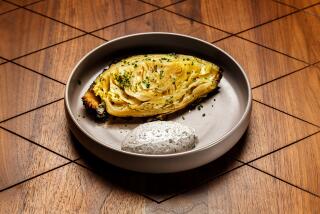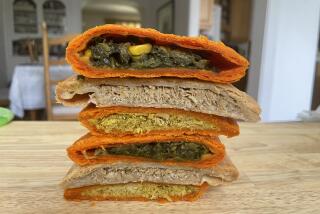Potato Power: This Spud’s For You
- Share via
“Wretched” . . . “tasteless” . . . “the worst of all vegetables.” In his book “Food,” Waverly Root recounts nearly a dozen horrible slurs against the potato. Nietzsche, for instance, implied that eating potatoes could lead to alcoholism.
Early American settlers thought potatoes were fit only for the hogs.
But in 1989 the potato is trendy, deemed fit for power eaters and marketed as sexy. (As Danny de Vito proved, a lumpish figure is no obstacle to glamour and fame.)
With the resurgence of grill food, you can get potatoes the old-fashioned way--DC 3 and Engine Co. 28 have whole sections of their menus devoted to potato; at places like Chasen’s and The Grill, you’ve always been able to get them 10 different ways.
More and more, though, you find potatoes as integral parts of entrees too. At restaurants such as Tulipe and Fennel, “potato jackets” encloak sea bass and lobster claws. At Citrus, Michel Richard tops an amazing potato “risotto” with scallops and hot potato chips. And at Patina (reviewed last week) potatoes are literally taking the place of pasta.
What changed? The New York Times dates the Power Potato era from the day WWD publisher John Fairchild asked for a baked potato as an appetizer in the Grill Room of New York’s Four Seasons restaurant Feb. 9, 1989, at 1:15 p.m. Now the baked potato is one of the Four Seasons’ best-selling appetizers.
But chic spudmania swept through France a few years ago. During the year of the potato, 1985, Jacques Maximin cooked five-course potato menus, including a potato dessert (potato souffle with rum and candied sugar crystals). Three-star chef Michel Guerard added truffles to potato hash and made a humble dish luxurious. Maison Blanche chef Jose Lampreia substituted fruity extra-virgin olive oil for the usual butter, and got the cream of the Parisian elite clamoring for second helpings of mashed potatoes.
In Los Angeles, the brave new potato hit when 72 Market St. opened in 1984. Taking his cue from the diner craze of the early ‘80s, chef Leonard Schwartz decided to try putting meat loaf and mashed potatoes in a serious restaurant context. “There’s always been a place for what the French call pommes puree in the French bourgeois or country-style tradition,” says Schwartz who is currently working at just-opened Market St. sequel, Maple Drive. “Honestly, what was more difficult was the meat loaf.” But the meat loaf wasn’t the only thing that critics raved about; Schwartz’s perfect potatoes were the talk of the town. “We use a lot of butter and cream,” Schwartz says, “which gives them a more decadent quality--helps them transcend their more pedestrian nature.”
But Los Angeles’ most inventive potato chef is undoubtably Patina’s Joachim Splichal. His menu reveals rampant potato use: shrimp with mashed potatoes and potato-truffle chips . . . gratin of lamb with mashed potatoes . . . stack of potato salad with John Dory . . . potato and mushroom “lasagna” . . . potato “ravioli” with oysters . . . metamorphosis of a potato, garlic and thyme terrine into a soup.
“I like potatoes--it’s my background,” says Splichal, who was born and reared in West Germany. But there has been some resistence to his potato-heavy menu from a contingent of eaters Splichal calls “the pasta people.”
“They ask, ‘Why so much potato? or ‘Where’s the pasta?’ But I don’t serve potato as a starch; it’s more of a principal item here.”
His potato salad, for instance--a delicate construction of thin layers of potatoes stacked between layers of fish--is nothing you’d take on a picnic. It’s one of several dishes Splichal invented when he came across a Japanese utensil (normally used for daikon) that can peel a potato into one continuous paper-thin sheet. Splichal uses these sheets as pasta; he’s experimenting with “spaghetti” made with julienned potato.
It’s the neutral blandness of the potato that is its biggest advantage in these more unusual structures. “It doesn’t compete with the ingredients you want to put with it,” says Campanile’s Mark Peel, who sometimes uses potatoes and mushrooms to fill ravioli. Apparently, even chocolate doesn’t clash with potato; Peel’s wife and partner, Nancy Silverton, used to make potato brownies for Spago (“(The potatoes) keep them moist,” she says).
“When I took this account 17 years ago,” says Maggie Waldron, who does promotion for the U.S. Potato Board, “potato sales had seriously dropped off--everybody seemed to be on a diet and potatoes were getting a bad rap for being fattening. It took a long time to change those perceptions.
“We started with a gentle campaign,” Waldron says. “But then we decided to really hit it with the Lies! Lies! Lies! ad, which pointed out all the myths about potatoes. Then we started trying to make people think of potatoes as a vegetable, not a starch.” The ads appeared in glossy mags, even Vogue, and seem to have had an effect. The Potato Board now touts its tuber product as “America’s favorite vegetable.”
It’s not Asia’s, though. Two years ago Waldron went on a good-will potato tour of Asia with Mark Peel to demonstrate recipes. “The problem in Japan,” Waldron says, “is the trade barrier. We have to ship our potatoes to them frozen.” That means French fries are a big success there, but dishes like potato ravioli will have to wait. Still, the Potato Board isn’t about to give up. A new MTV-like potato video starring Peel is about to be released in the Japanese market.
More to Read
Eat your way across L.A.
Get our weekly Tasting Notes newsletter for reviews, news and more.
You may occasionally receive promotional content from the Los Angeles Times.









